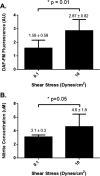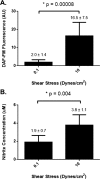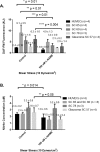Shear stress-triggered nitric oxide release from Schlemm's canal cells
- PMID: 25395486
- PMCID: PMC4266075
- DOI: 10.1167/iovs.14-14722
Shear stress-triggered nitric oxide release from Schlemm's canal cells
Abstract
Purpose: Endothelial nitric oxide (NO) synthase is regulated by shear stress. At elevated intraocular pressures when the Schlemm's canal (SC) begins to collapse, shear stress is comparable with that in large arteries. We investigated the relationship between NO production and shear stress in cultured human SC cells.
Methods: Schlemm's canal endothelial cells isolated from three normal and two glaucomatous human donors were seeded into Ibidi flow chambers at confluence, cultured for 7 days, and subjected to steady shear stress (0.1 or 10 dynes/cm(2)) for 6, 24, or 168 hours. Cell alignment with flow direction was monitored, and NO production was measured using 4-amino-5-methylamino-2',7'-difluorofluorescein (DAF-FM) and Griess reagents. Human trabecular meshwork (TM) and umbilical vein endothelial cells (HUVECs) were used as controls.
Results: Normal SC strains aligned with the direction of flow by 7 days. Comparing 0.1 vs. 10 dynes/cm(2), NO levels increased by 82% at 24 hours and 8-fold after 7 days by DAF-FM, and similar results were obtained with Griess reagent. Shear responses by SC cells at 24 hours were comparable with HUVECs, and greater than TM cells, which appeared shear-insensitive. Nitric oxide production by SC cells was detectable as early as 6 hours and was inhibited by 100 μM nitro-L-arginine methyl ester. Two glaucomatous SC cell strains were either unresponsive or lifted from the plate in the face of shear.
Conclusions: Shear stress triggers NO production in human SC cells, similar to other vascular endothelia. Increased shear stress and NO production during SC collapse at elevated intraocular pressures may in part mediate IOP homeostasis.
Keywords: aqueous humor; conventional outflow; eNOS; glaucoma; intraocular pressure.
Copyright 2014 The Association for Research in Vision and Ophthalmology, Inc.
Figures








References
-
- Predescu D, Predescu S, Shimizu J, Miyawaki-Shimizu K, Malik AB. Constitutive eNOS-derived nitric oxide is a determinant of endothelial junctional integrity. Am J Physiol Lung Cell Mol Physiol. 2005; 289: L371–L381. - PubMed
-
- Colasanti M, Suzuki H. The dual personality of NO. Trends Pharmacol Sci. 2000; 21: 249–252. - PubMed
-
- Harrison DG, Cai H. Endothelial control of vasomotion and nitric oxide production. Cardiol Clin. 2003; 21: 289–302. - PubMed
-
- Becquet F, Courtois Y, Goureau O. Nitric oxide in the eye: Multifaceted roles and diverse outcomes. Surv Ophthamol. 1997; 42: 71–82. - PubMed
Publication types
MeSH terms
Substances
Grants and funding
LinkOut - more resources
Full Text Sources
Other Literature Sources
Miscellaneous

